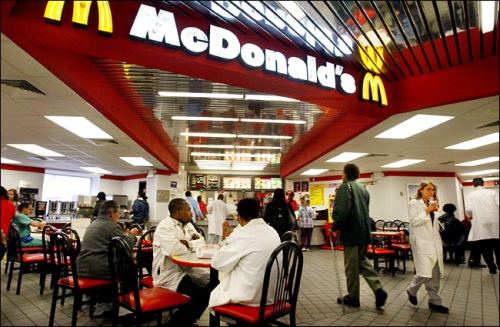Doctors Fight to Ban Fast Food From Hospitals – Good Reason.
– – – –
McDonald’s always seems to have its logo plastered where it doesn’t belong. Every four years, for example, millions watch in disgust as elite athletes smile into a camera, take a bite of a Big Mac, and swear their undying allegiance to the McFlag—all because the multibillion-dollar corporation shelled out a small fraction of its massive profits to become “The Official Restaurant of the Olympic Games.”
But while those high-profile ads are stealing the spotlight, the corporation has a more out-of-place, under-the-radar partnership: McDonald’s currently has contracts to serve food in 18 hospitals across the United States. The quick-serve mega chain doesn’t just serve burgers to guests in cafeterias—it also delivers meals right to sick patients’ beds, hosts birthday parties, and offers a snack menu with nachos and ice cream.
The medical profession is fighting back:
Cardiologist Aseem Malhotra of the Royal Free Hospital in London criticized these controversial marketing tactics in a June 2013 article published in the British Medical Journal. “The junk food industry’s aggressive and irresponsible marketing has even been allowed to hijack the very institutions that are supposed to set an example: our hospitals,” he wrote.
That view is echoed by the Physicians Committee for Responsible Medicine, a nonprofit organization based in Washington, D.C., that promotes preventive medicine and alternatives to animal research, and encourages what it describes as “higher standards of ethics and effectiveness in research.”
The committee has been doing a series of hospital food reports to analyze just how dire the situation is. In their fifth and most recently published installment, experts surveyed more than 200 hospitals around the nation and discovered McDonald’s isn’t the only offender: Chick-Fil-A is in 20 hospitals, and Wendy’s is in five. Most of the hospitals are located in the South, where, according to Centers for Disease Control statistics, obesity rates are disproportionately high.
It’s one thing for the restaurants to be inside the hospitals, but it’s another for their finances to be inextricably linked. The committee analyzed five different contracts and found that the hospitals are actually incentivized to help the fast-food restaurants sell more processed junk food.
In one example, the McDonald’s inside Ben Taub General Hospital in Houston “can terminate its lease if yearly gross sales of Big Macs and other junk foods do not reach $1 million,” the committee’s report states. “Moreover, the monthly rent McDonald’s pays to the hospital increases based on food sales.”
For every Big Mac sold and for every McNugget dunked in corn syrup-y barbecue sauce, the hospital drops another dollar in its theoretical pockets.

But, as the report states, there is hope, and conditions have been improving. Since the committee started issuing its food reports, two hospitals mentioned have removed the junk food: McDonald’s closed at Riley Hospital for Children at Indiana University Health, and St. Louis Children’s Hospital no longer carries Dairy Queen products. Several other fast-food restaurants have also recently closed in hospitals around the country.
The committee also mentions that more and more hospitals have been adding fresh fruits and vegetables to their cafeterias. But PCRM’s president, Neal Barnard, wants to take it one step further: “Just as cigarettes are banned from hospitals, why not do the same for meat, cheese, and other junk foods?”

